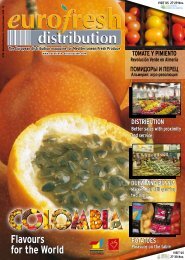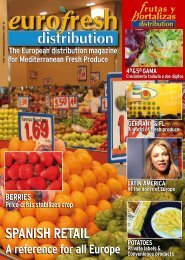You also want an ePaper? Increase the reach of your titles
YUMPU automatically turns print PDFs into web optimized ePapers that Google loves.
20<br />
DiStributioN/DiStribucióN<br />
United Kingdom,<br />
world benchmark<br />
for food retailing<br />
Major firms diversify their range and keep ahead of<br />
consumer trends to meet their customers’ needs<br />
After experiencing higher growth than<br />
other European countries in recent<br />
years, the British economy slowed to<br />
1.9% growth in 2005. The forecasts<br />
expect a recovery, with growth rising<br />
to 2.8%. The UK retail sector showed<br />
annual growth of 1.9% in 2005 and<br />
2.8% in 2006. The inflation rate was<br />
2% in 2005 and household debt was<br />
117% of gross disposable income at<br />
the end of that year.<br />
The British consumer<br />
The birth rate is falling and IGD estimates<br />
that by 2014 the over-65s<br />
will outnumber those under 16. The<br />
ageing population will have consequences<br />
for food consumption in the<br />
United Kingdom because the future<br />
pensioners of 2020 are today’s regular<br />
consumers of ready-prepared<br />
dishes, which is also a consequence<br />
of households having fewer members.<br />
Also, consumers have less<br />
time for shopping and are choosing<br />
convenience stores, avoiding the<br />
traffic jams at the volume retailers.<br />
Food retailing<br />
Specialised studies estimated food<br />
retailing turnover at GBP 90 billion<br />
(thousand million), over 130 billion<br />
euros, in 1998. The same source estimated<br />
that it had risen to GBP 100<br />
billion (147 billion Euros) in 2003.<br />
On 10 March 2006 The Times newspaper<br />
calculated GBP 95 billion. The<br />
British multiples sell a wide range of<br />
ethnic products and a large quantity<br />
of dishes prepared with products imported<br />
from different countries. They<br />
have created a new positive image<br />
by deciding to strengthen local products<br />
and by the efforts they make to<br />
ensure food safety.<br />
According to data from AC NIELSEN,<br />
28% of the products sold in the<br />
United Kingdom in April 2005 were<br />
retailer brands, which had grown by<br />
1% year on year. They made up 24%<br />
of sales by cooperatives, 73% at the<br />
discounters and 40% in large multiples<br />
such as Tesco or Sainsbury’s.<br />
Retailers have developed various<br />
levels of private label depending on<br />
the quality. High quality private labels<br />
(Tesco Finest, Sainsbury’s Taste<br />
the Difference, with sales worth over<br />
GBP 1 billion in April 2006) and those<br />
in the lower range (Sainsbury’s Basics,<br />
Asda Essentials...) each have<br />
their own specifications and their<br />
own packaging. At the same time,<br />
the major multiples have expanded<br />
their service to consumers: long<br />
opening hours, goods returned if not<br />
satisfied, disabled access, etc. Also,<br />
to cut down the number of suppliers<br />
and the associated costs, the British<br />
supermarkets have opted to work<br />
with external operators known as Category<br />
Managers. Their work covers<br />
choosing the suppliers and product<br />
ranges and defining the marketing<br />
strategies (promotion, positioning,<br />
packaging).<br />
Most of the sector is British-owned,<br />
despite the prominence of a North<br />
American group, Wal Mart, since its<br />
takeover of Asda in 1999 and the entry<br />
of German groups on the discounter<br />
circuit. Internationally, only the Tesco<br />
group has expanded abroad, but its<br />
core business remains in the United<br />
Kingdom.<br />
Sector segmentation<br />
Food retailing operators fall into the<br />
following groups: Firstly the ‘Big 4’<br />
(the 4 major supermarket groups that<br />
aspire to the leadership): between<br />
them, Tesco, Asda, Sainsbury’s and<br />
Morrisons have 75% of the grocery<br />
market as well as each having a market<br />
share in excess of 10% and extensive<br />
nation-wide coverage. Then<br />
there are the groups that aim to<br />
differentiate themselves, Waitrose<br />
and Marks and Spencer, which have<br />
around 7% of the grocery market.<br />
They aim to capture a growing clientèle<br />
that looks for quality products<br />
or a large service component (e.g.<br />
prepared salads) or differentiated<br />
products (e.g. biscuits manufactured<br />
at the point of sale). A further group<br />
are the separate smaller multiple<br />
brands, which account for 11% of the<br />
ApRIl<br />
MAY<br />
2 0 0 7<br />
grocery market: Somerfield (4.2 %),<br />
the Co-ops (5 %) and Iceland (2%).<br />
Among the chains of independents<br />
and small franchises (4% of the<br />
market) the leading groups are Spar<br />
and Kwik Save; for discounters (3%<br />
market share) the main names are<br />
Lidl, Aldi and Netto. Lastly, it must<br />
be remembered that the up-market<br />
department stores have a line in<br />
food, with excellent grocery sections.<br />
Outlets such as Boots the Chemist,<br />
newspaper shops and tobacconists<br />
also offer all kinds of snacks, sandwiches<br />
and refreshments.<br />
Supermarkets<br />
According to the market studies<br />
company Verdict, between 1995 and<br />
2005 superstores (over 25,000 sq<br />
ft) increased their market share by<br />
6.2% to 41.8%, with sales worth an<br />
estimated 56.3 billion (thousand million).<br />
Hypermarkets (over 40,000 sq<br />
ft sales space) are scarcer in the United<br />
Kingdom than on the Continent.<br />
The main ones are Tesco and Asda.<br />
75% of total food product sales in the<br />
United Kingdom are made by the big<br />
4: Tesco alone controlled 31.1% of the<br />
market in the first half of 2006. Tesco<br />
was the great winner in 2005 as well,<br />
with over half of the market growth in<br />
the past 5 years (the grocery market<br />
has risen to GBP 125 billion). Since<br />
2000, Tesco has gained 6 times<br />
more market share than the next 4<br />
combined (Sainsbury’s, Morrisons,<br />
Asda and Somerfield). According to<br />
Verdict, Tesco’s returns on its total<br />
retail sales are GBP 1 for every GBP 8<br />
of expenditure, in other words, twice<br />
as much as any other retailer.<br />
According to the British press, these<br />
EUROFRESH<br />
DISTRIBUTION<br />
multiples will have 91% of the market<br />
in 2010, thanks to their ability to keep<br />
a step ahead of the changing lifestyle<br />
of the British consumer.<br />
Trends<br />
As the sector is increasingly competitive<br />
and subject to buy-outs and<br />
mergers, the major groups are developing<br />
their business into other<br />
segments, both as regards products,<br />
by giving priority to local supplies<br />
(distinguished by the little red tractor<br />
logo), and by diversifying into nonfood<br />
products. These are considered<br />
a great development opportunity, as<br />
it is easier to obtain permission for<br />
this type of shop and the products<br />
increase customer loyalty. Non-food<br />
product sales in supermarkets in<br />
2005 reached GBP 6.8 billion (10<br />
thousand million euros), up 13% on<br />
2004.<br />
Between 2006 and 2010, Keynote<br />
calculates that online sales will grow<br />
by 20% annually to GBP 3.1 billion<br />
(4.5 hundred thousand euros) and<br />
account for around 3.2% of the total<br />
UK food retailing market. The convenience<br />
store market in the United Kingdom<br />
is estimated at GBP 25 billion<br />
(a little over 36 hundred thousand<br />
euros). This includes all the operators<br />
in the sector and all categories<br />
of products sold, both food and nonfood.<br />
The expansion of the supermarket<br />
chains is now taking place in<br />
this area, owing to the difficulties in<br />
obtaining permission to open large<br />
out-of-town stores. The forecasts for<br />
convenience food retailing are rosy:<br />
sales will rise to GBP 30-40 billion<br />
(44.1-58.8 thousand million euros)<br />
by 2011.<br />
<strong>89</strong>




